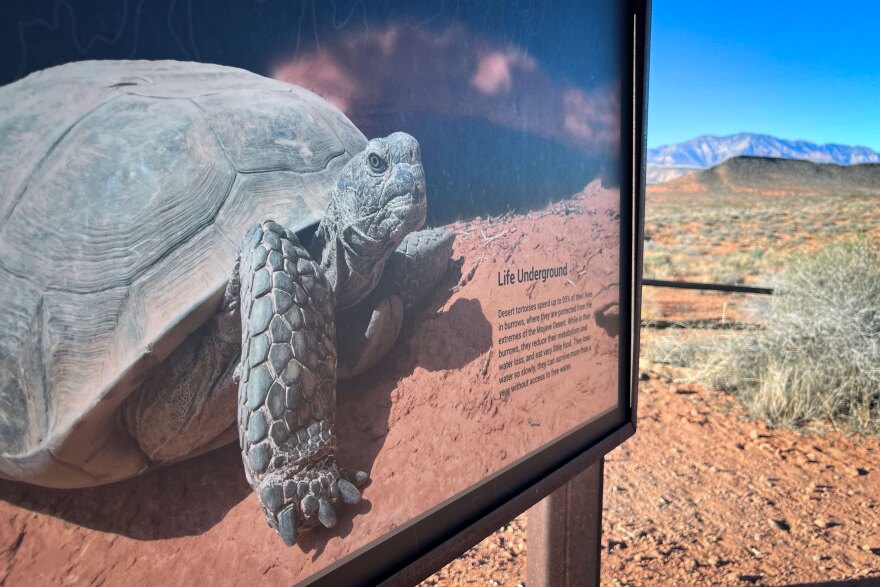The saga of the Northern Corridor Highway has taken another turn.
The Bureau of Land Management and the U.S. Fish and Wildlife Service approved the controversial highway in 2021, in the final days of President Donald Trump’s first term. The agencies reversed their decision last year under President Joe Biden, rejecting the plan to build a 4.5-mile road through threatened Mojave Desert tortoise habitat in Red Cliffs National Conservation Area near St. George.
Now with Trump back in office, the BLM is reevaluating the proposal. Local leaders, who have long said the fast-growing community needs the road to prepare for future traffic, welcomed the news.
“We think that the previous decision from the Biden administration was completely politically motivated,” Washington County Commissioner Adam Snow said. “So, we're glad that they're taking another look.”
Environmental groups counter that permitting the highway would go against the federal agencies’ mandate to preserve the natural landscape. It comes down to one foundational question, said Todd Tucci, a senior attorney with Advocates for the West who has led lawsuits to stop the project.
“Is a four-lane, high-speed highway through a national conservation area consistent with the obligation to manage the area, to conserve, protect and enhance Mojave Desert tortoise populations and habitat?” Tucci said. “Every reasonable scientist — agency scientist and otherwise — that has looked at this has said, ‘No.’”
If the road is built through Red Cliffs, he said, it could set a dangerous precedent that threatens the future of protected lands across the West.
“This is not just a Utah thing. This is not just a Washington County thing. This should send shivers through the body of every person that has a landscape that they love,” Tucci said.

The 2024 Biden administration decision endorsed an alternative plan to expand the existing Red Hills Parkway. It cited concerns that the Northern Corridor Highway could increase wildfire risk and spread invasive plants by bringing more vehicles into the protected land.
The BLM’s reassessment document, released in early October, however, eliminates the Red Hills Parkway expansion alternative, saying it would present “severe technical and economic challenges.” The agency report says the expansion would close or relocate at least 13 businesses operating along the parkway, and it questions whether the new I-15 interchange that the alternative requires would meet federal standards.
Instead, the agency is considering five other alternatives, including three different routes for a highway through the conservation area.

Projections from the University of Utah say Washington County’s population could double to more than 400,000 by 2050. Because of the mesas and ridges that surround St. George, Snow said, there are limited options for adding roads to move people east-west. So, he continues to believe the Northern Corridor is the best available path.
“I'm confident eventually this will happen,” Snow said. “It's just how many dollars and how many years do we have to waste in the meantime?”
A nearby piece of land, called Zone 6, is another layer of the debate. It’s home to tortoise habitat, mountain biking trails and rock climbing, and it gained conservation protection as part of a swap when the highway was previously approved in 2021.
But Utah officials have said 2,782 acres of Zone 6 could soon be developed into homes, unless the highway is built.
“This is a rare occasion when we can have a win-win-win for recreationists, for conservationists and to accomplish our transportation needs,” Snow said.
Even if the highway doesn’t happen, conservation groups argue, local and state leaders could find other ways to preserve Zone 6.
The BLM could issue a decision in favor of the highway plan by the late fall or early winter, Tucci said, despite past concerns from people who live near the proposed route and thousands of others who have sent public comments in previous rounds of federal planning.
If a new approval for the highway is signed, Tucci’s clients — which include Conserve Southwest Utah and the Southern Utah Wilderness Alliance — will be prepared to launch another lawsuit.
“I can assure them that the recreationists, the conservation groups and the outdoorsmen that have fought to protect Red Cliffs National Conservation Area in the past will do the same in the future,” he said. “This is not the end. This is the beginning.”
The public can submit comments about the plan to the BLM through Nov. 3.






